For members of the West Coast shellfish industry, their world is the oyster. Every year the industry harvests and sells millions of dollars worth of oysters, clams, and mussels, and demand for these delicacies is on the rise.
Unfortunately, the oyster industry’s ability to meet these demands is hampered by two species of burrowing shrimp. The ghost shrimp (Neotrypaea californiensis) and the mud shrimp (Upogebia pugettensis) inhabit the tideflats in estuaries where the oysters are grown. The shrimp burrow into the tideflats, making the sand and mud soft and unstable. As a result, oysters and other shellfish can sink beneath the silty surface and suffocate.
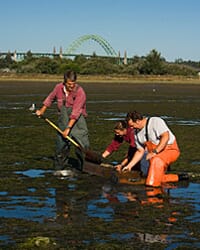 |
| Ecologist Brett Dumbauld shovels estuarine sediment from a metal core into a sieve while technicians Cara Fritz and Roy Hildenbrand collect burrowing shrimp to measure and examine the effects of these pests on the oyster aquaculture industry. (D1106-20) |
Dumbauld is working with scientists at Washington State University and Oregon State University (OSU) to develop sustainable shrimp-control strategies to assist the oyster industry.
Since the 1960s, Washington oyster growers have applied the pesticide carbaryl to keep shrimp populations in check. But, in compliance with an out-of-court settlement, they’ve agreed to stop using it by 2012. So Dumbauld and his colleagues are uncovering information about the shrimps’ habitats, life history, and natural predators—information that can be used to help develop new methods to protect oysters from these pests.
The Facts of Shrimp Life
To determine when ghost and mud shrimp are most vulnerable to various control methods, Dumbauld examined the organisms’ life histories. He hypothesized that controls would be most effective directly after “recruitment”—that’s when an influx of young shrimp enters the estuaries from the ocean. At this point, the shrimp live in small burrows near the surface of the estuary flats, where they are potentially more vulnerable to predators and environmental factors.
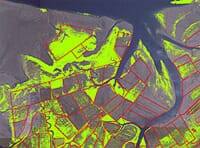 |
| Color infrared aerial photograph of a portion of Willapa Bay (in Washington State) showing vegetation layer (green) areas. Oyster aquaculture areas are outlined in red. In combination with additional layers showing burrowing shrimp distribution, maps such as this can show the effects of aquaculture and pest-control strategies at the estuarine landscape scale. (D1113-1) |
Dumbauld studied several shrimp populations in Washington and Oregon estuaries and observed considerable differences in the number of young shrimp.
“The size of the juvenile population, which is an indication of recruitment from the ocean, differs between the shrimp species,” Dumbauld says. “We also observed that numbers varied between estuaries and from year to year.”
This is significant because being able to predict high recruitment could make control strategies much more effective by improving the timing, intensity, and targeting of treatment.
In a related study, Dumbauld and Tony D’Andrea, an assistant professor at OSU, worked with OSU graduate student Katelyn Cassidy to examine the amount of lipofuscin—an aging pigment—in the shrimps’ neural systems.
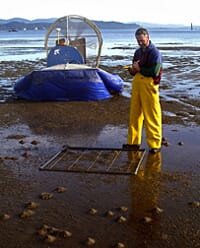 |
| Using a handheld GPS unit, technician Lee McCoy records data on shrimp burrow density and aquatic vegetation cover. A hovercraft (in the background) is used to traverse the estuary’s 6,000 acres of intertidal mud and sandflat areas—inaccessible by most other means. (D1112-1) |
“This information could be used to develop predictive tools for targeting and controlling shrimp at the recruitment stage and for using alternative mechanical, biological, and perhaps even less-toxic chemical controls that don’t work for adults but might be more effective for young shrimp,” Dumbauld says.
Parasite Power
Dumbauld is also collaborating with scientists at the U.S. Environmental Protection Agency’s Pacific Coastal Ecology Branch. They’re using aerial photographs to create maps of the areas inhabited by the oysters and shrimp in Willapa Bay, Washington—one of the nation’s biggest producers of farmed oysters.
“This will enable us to examine the effects of aquaculture practices, including shrimp control, at the landscape scale,” Dumbauld says. “The ultimate goal is to develop best-management practices for aquaculture in these estuaries.”
The maps will help scientists determine how shrimp populations are distributed and whether control measures can be more effectively deployed on a large scale. This type of information is also critical to developing successful integrated pest-management strategies.
 |
| The amount of lipofuscin, a neural system pigment, can be measured and used to determine age in crustaceans that retain no hard parts as they grow. Here, Oregon State University student Katelyn Cassidy examines the brain of a shrimp with ARS ecologist Brett Dumbauld. The lipofuscin will later be extracted and measured using high-performance liquid chromatography. (D1108-14) |
The parasite sucks the shrimps’ blood, depleting their energy levels to the extent that they can no longer reproduce. Infested populations suffer significant reproductive declines—as much as 85 percent in some locations. It appears that this loss of reproductive capacity has caused the mud shrimp populations to collapse in some estuaries.
Dumbauld is working with John Chapman, an OSU professor, to investigate the dynamics of this parasite-host relationship and to determine whether a related parasite could be used to control ghost shrimp populations.
These studies lay the foundation for sustainable practices that will support the growth of the West Coast oyster industry.—By Laura McGinnis, Agricultural Research Service Information Staff.
This research is part of Aquaculture, an ARS national program (#106) described on the World Wide Web at www.nps.ars.usda.gov.
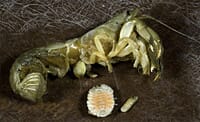 |
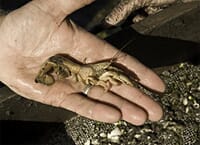 |
|
| Mud shrimp (Upogebia pugettensis) are one of two shrimp species causing problems for oysters. These shrimp are often heavily parasitized by isopods that suck the shrimp’s blood and make them unable to reproduce. Griffen’s isopod (Orthione griffenis, here removed from the underside of a shrimp’s carapace) may be causing shrimp populations in several West Coast estuaries to collapse. (D1109-11) | Griffen’s isopod (Orthione griffenis, recognizable here as the bulge under the carapace of the shrimp) may be causing shrimp populations in several West Coast estuaries to collapse. (D1107-7) |
"Reducing Burrowing Shrimps’ Impact on Oyster Production" was published in the May/June 2008 issue of Agricultural Research magazine.
View the USDA article on Present and Future Issues in Aquaculture by clicking here.
May 2008

